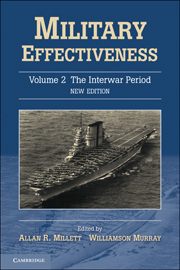Book contents
- Frontmatter
- Contents
- List of Contributors
- Introduction: Military Effectiveness Twenty Years After
- Maps
- 1 The Soviet Armed Forces in the Interwar Period
- 2 The French Armed Forces, 1918–40
- 3 The Military Effectiveness of the US Armed Forces, 1919–39
- 4 The British Armed Forces, 1918–39
- 5 Japanese Military Effectiveness: The Interwar Period
- 6 The Italian Armed Forces, 1918–40
- 7 German Military Effectiveness between 1919 and 1939
- 8 Military Effectiveness of Armed Forces in the Interwar Period, 1919–41: A Review
- Index
7 - German Military Effectiveness between 1919 and 1939
Published online by Cambridge University Press: 05 June 2012
- Frontmatter
- Contents
- List of Contributors
- Introduction: Military Effectiveness Twenty Years After
- Maps
- 1 The Soviet Armed Forces in the Interwar Period
- 2 The French Armed Forces, 1918–40
- 3 The Military Effectiveness of the US Armed Forces, 1919–39
- 4 The British Armed Forces, 1918–39
- 5 Japanese Military Effectiveness: The Interwar Period
- 6 The Italian Armed Forces, 1918–40
- 7 German Military Effectiveness between 1919 and 1939
- 8 Military Effectiveness of Armed Forces in the Interwar Period, 1919–41: A Review
- Index
Summary
Introduction
Between 1919 and 1935 one cannot speak of a consistent level of German military effectiveness. For much of the period the German state, situated between relatively strong neighbors, possessed only a small professional army that could not produce sufficient reserves to face even one of its neighbors. The miniscule navy was even less significant. What makes a comparison between the Weimar and the Nazi period doubtful in another respect is the totally different political structures of both systems. On the other hand, there were elements that contributed to a continuity and that must be addressed in any attempt to analyze Germany's military effectiveness during the interwar period.
Both phases of the 1919–39 period were characterized by a resolution to overturn the Versailles Treaty and to regain Germany's position as a great power. Political, strategic, and operational ideas and plans changed; conditions altered, but the goal – to build up modern ground forces supported by a powerful air force and ready to wage a war to reshape Europe politically – was the same.
Adolf Hitler's desire to achieve this goal in a shorter period was one of the major new accents introduced after 1933. It proved to be a decisive one. Its impact on German finances, resources, and the whole economy was serious and created new conditions demanding desperate responses.
During both of these phases the Reichswehr and Wehrmacht were occupied in defining their positions within the state. There was, however, a vital difference in context between the republican system and the thoroughly militarized Führerstaat.
- Type
- Chapter
- Information
- Military Effectiveness , pp. 218 - 255Publisher: Cambridge University PressPrint publication year: 2010
- 1
- Cited by



